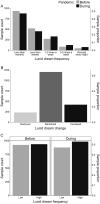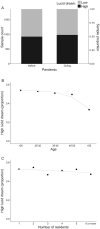Lucid dreaming increased during the COVID-19 pandemic: An online survey
- PMID: 36103479
- PMCID: PMC9473433
- DOI: 10.1371/journal.pone.0273281
Lucid dreaming increased during the COVID-19 pandemic: An online survey
Abstract
The COVID-19 pandemic changed people's lives all over the world. While anxiety and stress decreased sleep quality for most people, an increase in total sleep time was also observed in certain cohorts. Dream recall frequency also increased, especially for nightmares. However, to date, there are no consistent reports focusing on pandemic-related changes in lucid dreaming, a state during which dreamers become conscious of being in a dream as it unfolds. Here we investigated lucid dreaming recall frequency and other sleep variables in 1,857 Brazilian subjects, using an online questionnaire. Firstly, we found that most participants (64.78%) maintained their lucid dream recall frequency during the pandemic, but a considerable fraction (22.62%) informed that lucid dreams became more frequent, whereas a smaller subset (12.60%) reported a decrease in these events during the pandemic. Secondly, the number of participants reporting lucid dreams at least once per week increased during the pandemic. Using a mixed logistic regression model, we confirmed that the pandemic significantly enhanced the recall frequency of lucid dreams (p = 0.002). Such increase in lucid dreaming during the pandemic was significantly associated with an enhancement in both dream and nightmare recall frequencies, as well as with sleep quality and symptoms of REM sleep behavior disorder. Pandemic-related increases in stress, anxiety, sleep fragmentation, and sleep extension, which enhance REM sleep awakening, may be associated with the increase in the occurrence of lucid dreams, dreams in general, and nightmares.
Conflict of interest statement
The authors have declared that no competing interests exist.
Figures



References
-
- World Health Organization. WHO Director—General’ s opening remarks at the media briefing on COVID-19. 2020, March 11. https://www.who.int/dg/speeches/detail/who-directorgeneral-s-opening-rem...
Publication types
MeSH terms
LinkOut - more resources
Full Text Sources
Medical

